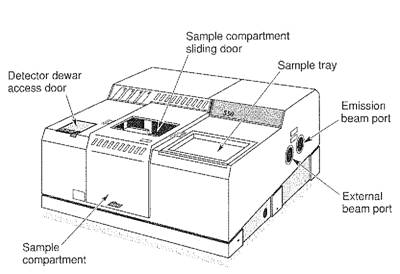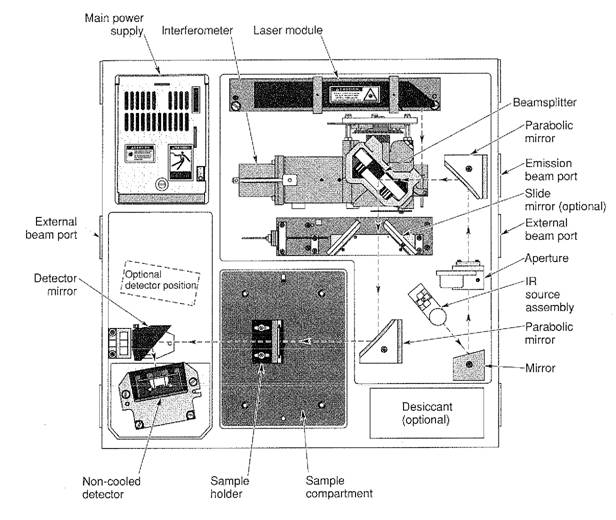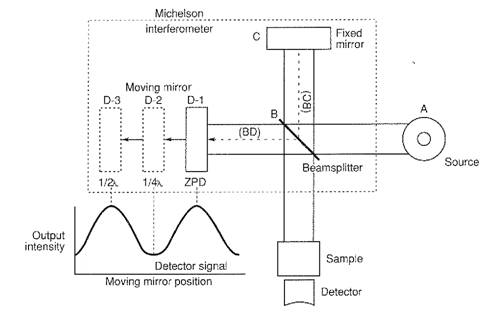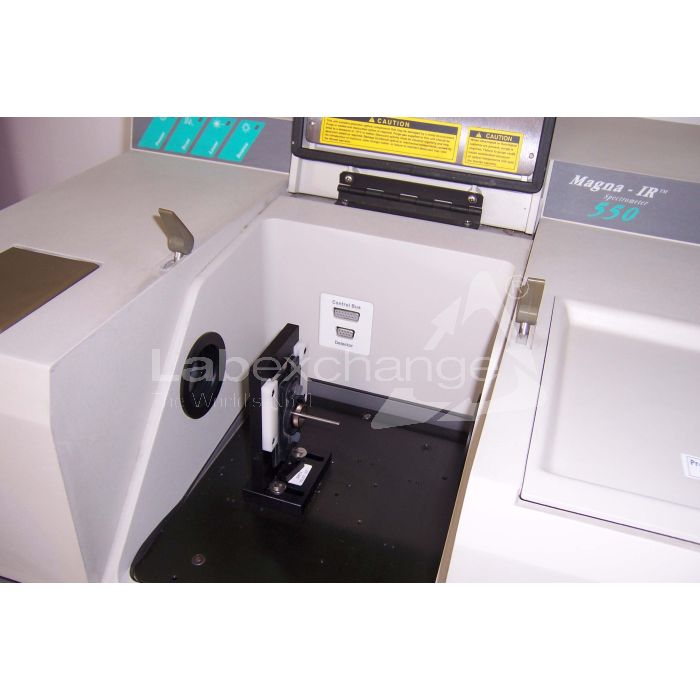Nicolet Magna IR 550
| Objektnummer | B00017277 |
|---|---|
| Seriennummer | 017277 |
| Object Naam | Nicolet Magna IR 550 |
| Status | Stock unit |
Product groep: IR spectrometers
Status, leverings- en betalingsvoorwaarden
Apparatuurcontrole
De gebruikte apparatuur wordt voorafgaand aan levering gecontroleerd door Labexchange Service GmbH. U ontvangt volledig functionerende apparatuur.
Verzending
De vermelde verzendtijden zijn telkens de kortste voor een artikel. In bepaalde gevallen kunnen de daadwerkelijke verzendtijden daarvan afwijken. De uiteindelijke verzendtijden worden aangegeven in de opdrachtbevestiging.
In de regel bieden we combinatieleveringen aan. Levertijden zijn afhankelijk van het artikel met de langste levertijd. Deelleveringen zijn mogelijk tegen een toeslag.
Verzendmethoden
Koeriersdiensten, transportbedrijven, zelf afhalen, levering door Labexchange wagenpark
Informatie levering
De prijzen zijn exclusief verzendkosten. De genoemde verzendkosten zijn de te verwachten kosten. Afwijkingen zijn mogelijk. In het geval geen kosten voor verzending zijn gespecificeerd, vraag die dan afzonderlijk aan.
De opgegeven vracht- en verpakkingskosten hebben betrekking op de goedkoopste transportroute en zijn onder voorbehoud van onvoorziene kostenstijgingen. Door onvoorziene gebeurtenissen kunnen vrachttarieven en levertijden op elk moment veranderen en moeten ze worden aangepast aan de huidige situatie. Incoterm coderingen volgens Incoterms 2010: Bij afhalen EXW, CFR voor zendingen over zee, CPT per luchtfracht, andere zendingen DAP. Opmerking: We geven geen preferentieel certificaat/EUR1 af. Bij zelf afhalen/af fabriek (EXW) uit derde landen en de EU wordt 16% btw als borg ingehouden, tot we de ontvangstbevestiging/het leveringscertificaat van de koper hebben ontvangen.
Betalingsvoorwaarden
Wij accepteren geen betalingen Letter of Credit, PayPal etc. Het factuurbedrag is volledig verschuldigd. Er zijn geen betalingskortingen. De goederen blijven tot volledige betaling ons eigendom.
|
Land |
Mogelijke betaalmethoden |
Opmerking |
|
Duitsland, Oostenrijk, Zwitserland |
Betaling via factuur, vooruitbetaling, per creditkaart |
Betaling via factuur is mogelijk voor ondernemingsklanten. |
|
Nederland, België en Luxemburg |
Betaling via factuur, vooruitbetaling, per creditkaart |
Betaling via factuur is mogelijk voor ondernemingsklanten. |
|
Andere landen |
vooruitbetaling, per creditkaart |
|
Onze Algemene Voorwaarden voor Verkoop, Levering en Betaling zijn hierop van toepassing. Deze voorwaarden zijn hier te downloaden.
Tussenverkoop is ons voorbehouden.
Beschrijving status:
Alle artikelen zijn gebruikte artikelen, tenzij bij een artikel uitdrukkelijk wordt vermeld dat het om een nieuw apparaat gaat.
manufacturer : Nicolet
model : Magna IR 550
annotation : Dokumente engl.
The following illustrations and descriptions refer to the instrument model and are drawn from brochures. They do not represent the scope of delivery. Please refer to the text of the offer for the exact scope of delivery.

Nicolet's Magna-IR System 550 is a complete spectrometer capable of up to 0.125 cm-1 resolution. The interferometer Features Auto-Tune system alignment and continuous dynamic alignment. Using precise Digital Signal Processing (DSP), the interferometer provides exact scan reproclucibility and collection of miaute signals.
The System 550 is designed Wand-, near-, and far-infrared spectral range coverage. Spectra may be collected and sequentially stored at raten of up to 20 scans per second using the Rapid Scan option.
All optical bench functions are fully automated and controlled via Nicolet's OMNICTM software. Diagnostic status of all system components is reported to the FT-IR workstation. Multiple scanning velocities, a variable-diameter aperture, and multiple beam paths enable a wide array of experimental conditions.
The system has beeis designed so that you can install it yourself. You can also replace key parts of the optical bench, such as-thelaser and infrared source.
Optical Bench Description
The major components of the System 550 optical bench are identified and briefly described in düs chapter. Components are listed according to their order in the path of the infrared (IR) beam.

Source The IR beam of radiation is produced by the source. The System 550 is equipped with an Ever-GloTM mid-IR to far-IR source or a tungsten-halogen, near-IR source.
Aperture The aperture is a variable-diameter opening that can be adjusted to
control the arnount of IR radiation that reaches the sample.
The aperture can also be adjusted to achieve maximum spectral resolution.
Interferometer From the source the beam is reflected from mirrors into the interferometer, which splits the beam, modulates the intensity of all frequencies of IR light, and then recombines the beams. The interferometer features Auto-Tune system alignment and continuous dynamic alignment.
Beamsplitter This device inside the interferometer separates the beam into two beams of nearly equal energy. One of the beams is reflected from the beamsplitter to a fixed mirror and then back to the beamsplitter; the other beam is transmitted through the beamsplitter to a moving mirror and back to the beainsplitter, where the beams recombine.
Moving mirror While reflecting the IR beam back toward the beamsplitter, this mirror moves toward and away from the beamsplitter in a repeating cycle. This motion enables the computer to subsequently convert the beam to an IR spectrum.
Laser The laser is used as an internal calibrator in FT-IR instruments because it emits light at a known and constant frequency. All spectra are coliected at precise laser-calibrated points which generate wavenumber accuracy better than ±0.01 cm -1 . The laser helps control the moving mirror's position and signals the capture of data.
Sample compartment Samples are placed fiere for analysis. A focused IR beam. passes through (or reflects from) the sample and goes an to the detector.
Detector After beeng absorbed at specific frequencies by the sample, the
remainder of the beam is focused onto the detector, which produces an electrical signal in response to the energy striking it. The signal is sent to a computer for processing. The System 550 Features interchangeable detectors and has a dual detector option.
Sampling accessories Most accessories fit into the sample compartinent, but some require separate housing and optics. Nicolet offers auxiliary experiment modales, rnicroscopes and gas chromatography interfaces with the System 550.
Accessories that have their own optics require an external beam option. Mirrors are repositioned by computer commands to direct the IR beam through a port on the right or left si.de of the bench. The beam then travels into the accessory's optics.
Also available is an emission betan option, which allows collimated radiation from an external IR source to be directed through a port in the right side of the main bench and into the System 550 optics.
Note If you would like more information on how FT-IR spectrometers work, real the next section, "Fundamentals of IR Analysis."
Fundamentals of IR analysis
Infrared (IR) spectrometers measure the interaction of IR radiation with experimental samples. Spectormeters measure the frequencies at which the sample absorbs the radiation, and the intensities of the absorptions.
Determining these .frequencies al lows identification of the sample's chemical makeup, since chemical functional groups are known to absorb light at specific frequencies. Identification of what makes up the sample is called qualitative analysis, one of two major applications of IR spectrometry.
The other application. is quantitative analysis. The intensity of an absorption is related to the concentration of th.e component. After the spectrometer is calibrated, which establishes how concentration changes affect absorbance changes, the absorbance for an unknown sample can be used to calculate concentration.
Intensity and frequency of sample absorption are depicted in a twodimensional plot called a spectrum. Intensity is generally reported in terms of absorbance, the amount of light absorbed by a sample, or percent transmittance, the amount of light which passec through it. Frequency is usually reported in terrns of wavenumbers.
What makes up an unknown sample, and how rauch of each component is present in that sample, can be invaluable infortnation. Its many applications incl.ude research and development of new products, quality control of manufactured goods, forensic analysis and environmental testing.
FT-IR Spectrometers and how they work
IR light from the source ("A" in the Sketch below) is directed into the Michelson interferometer, the key component to FT-IR spectrometry. The interferometer modulates each wavelength of IR light at a different frequency.
In the interferometer the light beam strikes the beamsplitter (B), as shown below. About half of the light is reflected from the beamsplitter and is directed anto the fixed mirror (C). The remainder of light is transmitted through the beamsplitter and is directed onto the moving mirror (D). When the beams recombine, constructive or destructive interference occurs depending an the position of the moving mirror relative to the fixed mirror.

When both mirrors are the same distance from the beamspliner, the two reflected beams pass through exactly the same pathlength and, consequently, are totally in phase (distance BC = BD). The resulting signal intensity is at its maximum, a point called the Zero Path Difference (ZPD).
The modulated beam is reflected from mirrors to the sample, where selective absorption takes place.
From the sample the beam travels an to the detector, which translates the beam into an electrical signal.
The cosine waves produced by the source and modulated by the interferometer appear to the detector as ar7 interferogram, a signature of intensity versus mirror position. The interferogram is a summation of all the IR light frequencies; for all practical purposes it cannot be interpreted in its original form.
The signal from the detector is sent to a computer and converted into an IR spectrum through a mathematical formula called Fourier Transform (FT). The formula calculates- the ampl.itude of each of the component signals. The amplitude gives the intensity at the corresponding wavelength of light.
Zero path difference
Laser Specifications:
The source of laser energy in the System 550 optical bench is a nominal 1 milliwatt (maximum 1.2 milliwatt), continuous 632.8 nm laser head. In some jurisdicitons you may be required to register the optical bench, check with your companys safety officer or your local government offices. The following is an excerpt from the laser manufacturers manual regarding the information that might be needed for registration.
Manufacturer Melles Griot
Type of Laser Helium Neon (Hehe)
Wavelength 632.8 nm
Minimum Power 0.7 mW (TEM 00 )
Nominal Power 1.0 mW
Maximum Power 1.2 mW
Beam Diameter 0.65 cm (1/e 2 )
Beam Divergente 2.0 mrad
Spacing Cl2L 1039 MHz
Operating Voltage 12 VDC
CDRH Classification IIIa







